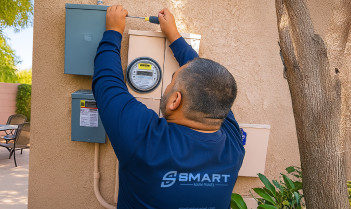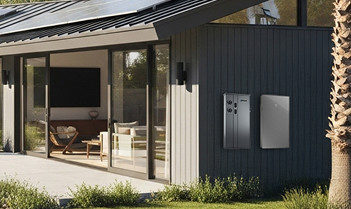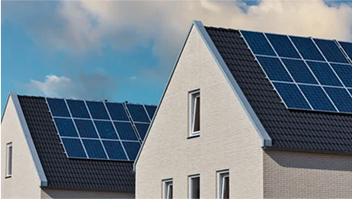Date
What Are The Most Common Electrical Panels?
You may not realize it, but electrical panels play a crucial role in providing power to your home or office. These panels are like the control center for your electrical system, distributing electricity to different circuits and ensuring everything functions smoothly. In this article, we will explore the most common types of electrical panels, giving you a better understanding of the options available and helping you make informed decisions when it comes to your electrical needs. So, let’s dive in and discover the world of electrical panels!

Main Breaker Panel
Description
The main breaker panel, also known as the service panel or electrical panel, is the heart of an electrical system in your home. It is typically located in a basement, garage, or utility room. This panel is where the main electrical power from the utility company enters your home and is distributed to different circuits throughout the house. It houses a large breaker, known as the main breaker, that controls the flow of electricity to the entire house.
Features
The main breaker panel is designed to handle a specific amperage, typically ranging from 100 to 400 amps. It consists of circuit breakers or fuses that protect individual circuits in your home. These breakers or fuses can be easily turned on or off, providing a convenient way to shut off power to specific areas of your house for maintenance or repair purposes. The panel is also equipped with neutral and grounding bars to ensure the safety of your electrical system.
Pros and Cons
One of the main advantages of a main breaker panel is its ability to cut off the power supply to your entire house in case of emergencies or electrical faults. This centralized control makes it safer and easier to manage your electrical system. Additionally, the main breaker panel allows for easy expansion and addition of new circuits as your electrical needs grow. However, the main disadvantage is that it can be expensive to install or upgrade, especially if your electrical demands exceed the capacity of your current panel.
Subpanel
Description
A subpanel, also called a subdistribution board, is an additional electrical panel that is connected to the main breaker panel. It is commonly installed in large houses or buildings with high electrical demands. The subpanel is used to distribute power to specific areas or circuits that are located far from the main breaker panel. It helps to alleviate the load on the main panel by providing additional circuit capacity.
Features
Similar to the main breaker panel, a subpanel consists of circuit breakers or fuses that protect individual circuits. It is connected to the main panel through a feeder cable, which carries the power from the main panel to the subpanel. The subpanel may also have its own grounding and neutral bars to ensure the safety and proper functioning of the electrical system.
Pros and Cons
The main advantage of a subpanel is its ability to distribute power to specific areas without overloading the main breaker panel. This is especially useful in large houses where the electrical demand is spread across different areas. Installing a subpanel also allows for easier organization and management of circuits. However, the cost of installing a subpanel, especially if it requires additional wiring and circuit breakers, can be a disadvantage for some homeowners.
Fuse Box
Description
A fuse box, also known as a fuse panel, is an older type of electrical panel that uses fuses instead of circuit breakers. It was commonly used in houses built before the 1960s. The purpose of a fuse box is to protect the electrical circuits from overloading and short circuits.
Features
In a fuse box, each circuit is connected to a fuse. When there is a power surge or overload, the fuse melts or blows, breaking the circuit and preventing damage to the electrical system. The blown fuse needs to be replaced manually. Fuse boxes typically have a main switch that shuts off the power supply to the entire house.
Pros and Cons
One advantage of a fuse box is its simplicity. It is relatively easy to understand and work with, as replacing a blown fuse is straightforward. Fuse boxes are also less expensive than modern circuit breaker panels. However, one major drawback is that fuses need to be replaced every time they blow, and it can be inconvenient and time-consuming to keep spare fuses and replace them when needed. Fuse boxes also offer limited protection compared to circuit breakers and may not meet modern safety standards.

Circuit Breaker Panel
Description
A circuit breaker panel, commonly referred to as a breaker box or circuit panel, is a modern alternative to fuse boxes. It is the most common type of electrical panel found in homes and buildings today. Circuit breakers provide protection against overloading and short circuits in electrical circuits.
Features
In a circuit breaker panel, each circuit is connected to a switch or breaker. When there is an electrical fault or overload, the breaker trips, interrupting the flow of electricity and protecting the circuit. Unlike fuses, circuit breakers can be reset manually without the need for replacement. The panel also typically includes a main breaker that controls the power supply to the entire house.
Pros and Cons
One major advantage of circuit breaker panels is their convenience. When a circuit trips, all you need to do is reset the breaker, avoiding the hassle of replacing fuses. Circuit breakers also provide better protection against overloads and short circuits, and they can be more precisely sized to match the electrical demands of different circuits. However, circuit breaker panels tend to be more expensive than fuse boxes, especially if they need to be upgraded to handle higher electrical loads.
Transfer Switch Panel
Description
A transfer switch panel is an electrical panel used in conjunction with a backup generator to provide temporary power during a utility power outage. It allows you to switch between the utility power supply and the generator power supply seamlessly, ensuring a continuous flow of electricity.
Features
A transfer switch panel typically has two main switches – one for the utility power and the other for the generator. During a power outage, the transfer switch panel detects the loss of utility power and automatically switches the electrical load to the generator. Once the utility power is restored, it switches back to the normal power supply. This prevents any interruption in the power supply to critical appliances or systems.
Pros and Cons
The main advantage of a transfer switch panel is its ability to provide reliable backup power during outages, ensuring that essential systems remain operational. It eliminates the need for manual connection of the generator to different circuits and enhances safety by preventing back-feeding of generator power into utility lines. However, the cost of purchasing and installing a transfer switch panel can be significantly higher compared to a standard breaker panel, making it a less popular option for homeowners who don’t experience frequent power outages.
Meter Socket Panel
Description
A meter socket panel, also known as a meter pack or meter base, is the point of connection between the electrical utility company’s meter and the home’s electrical system. It is typically located on the exterior of a house and provides a way for the utility company to measure the electricity consumed.
Features
A meter socket panel comprises the meter socket, where the utility company’s meter is installed, along with a disconnect switch or circuit breaker that allows you to shut off the power supply from the utility. It may also include additional circuit breakers or fuses to protect the meter and the electrical system.
Pros and Cons
One advantage of a meter socket panel is its simplicity and ease of installation. It serves as the point of connection with the utility company and allows for easy monitoring and measurement of electricity usage. However, a meter socket panel does not provide the same level of protection and control over individual circuits as a main breaker panel or circuit breaker panel. It is primarily responsible for housing the meter and ensuring a safe and reliable connection to the utility power supply.
Distribution Board
Description
A distribution board, also known as a breaker panel or electric panel board, is used to distribute electric power to various circuits within a building or structure. It is typically found in commercial or industrial settings, as well as in larger residential buildings.
Features
A distribution board consists of multiple circuit breakers or switches that control the distribution of power to different circuits. It is usually located close to the main power feed and acts as a central hub for electrical power distribution. Distribution boards may have additional features such as surge protection, phase monitoring, and individual circuit monitoring.
Pros and Cons
One advantage of a distribution board is its ability to handle a large number of circuits, making it suitable for commercial or industrial settings that require extensive electrical distribution. It provides a centralized and organized way to manage power distribution. However, distribution boards can be complex to install and maintain, requiring professional expertise. They are also more expensive than standard residential breaker panels and may not be necessary for smaller residential properties.
Load Center
Description
A load center, also known as a subpanel or load panel, is a smaller version of a main breaker panel. It is typically used to provide power to specific areas or subsystems within a building. Load centers are commonly found in garages, workshops, and other outbuildings that require separate electrical distribution.
Features
A load center is similar to a main breaker panel in terms of functionality and features. It consists of circuit breakers or fuses that protect individual circuits. The load center is connected to the main breaker panel through a feeder cable or conduit. It may have its own grounding and neutral bars, depending on the specific electrical requirements.
Pros and Cons
The main advantage of a load center is its versatility and flexibility in providing power to specific areas or subsystems. It allows for separate electrical distribution in outbuildings or areas that require additional power capacity. However, the installation of a load center requires careful planning and consideration of the electrical demands of the area or subsystem. It may also incur additional costs, depending on the distance from the main breaker panel.
Automatic Transfer Switch Panel
Description
An automatic transfer switch (ATS) panel is similar to a transfer switch panel but includes an automated mechanism for switching between the utility power and the backup generator power. It is commonly used in critical applications such as hospitals, data centers, and other facilities where uninterrupted power supply is crucial.
Features
An ATS panel includes the necessary switches, relays, and monitoring systems to automatically detect power outages and transfer the load to the backup generator. It ensures a seamless transition between the utility power and the generator power without any manual intervention. The ATS panel also monitors the availability and quality of the utility power, automatically restarting the generator when necessary.
Pros and Cons
The main advantage of an ATS panel is its ability to provide uninterrupted power supply without any manual intervention. It ensures that critical systems remain operational during power outages, minimizing the risk of data loss or equipment damage. However, ATS panels are complex and require professional installation and maintenance. They are also significantly more expensive than standard transfer switch panels, making them suitable only for applications where uninterrupted power supply is absolutely essential.
Service Panel
Description
A service panel, also known as an electrical service mast or weatherhead, is the point of connection between the electrical utility company’s power lines and the electrical panel in your home. It is typically located on the exterior of a house and houses the electrical meter and the point of connection for the utility power supply.
Features
A service panel includes the meter socket, where the utility company’s meter is installed, along with a main circuit breaker or disconnect switch that controls the power supply from the utility. It is usually mounted on a pole or the side of a building and is designed to protect the electrical system from weather conditions.
Pros and Cons
One advantage of a service panel is its functionality as the main point of connection between the utility power supply and your home’s electrical system. It ensures a safe and reliable connection to the utility power and allows for easy monitoring of electricity usage. However, a service panel does not provide individual circuit protection or distribution, making it less suitable for managing and controlling power distribution within the house. It primarily serves as the interface between your home and the utility company’s power lines.
In conclusion, there are various types of electrical panels available, each serving different purposes and meeting specific electrical requirements. The choice of panel depends on factors such as the size of the building, electrical demand, budget, and the need for specific features like backup power supply. It is important to consult with a qualified electrician to determine the most suitable electrical panel for your home or building to ensure a safe and efficient electrical system.



